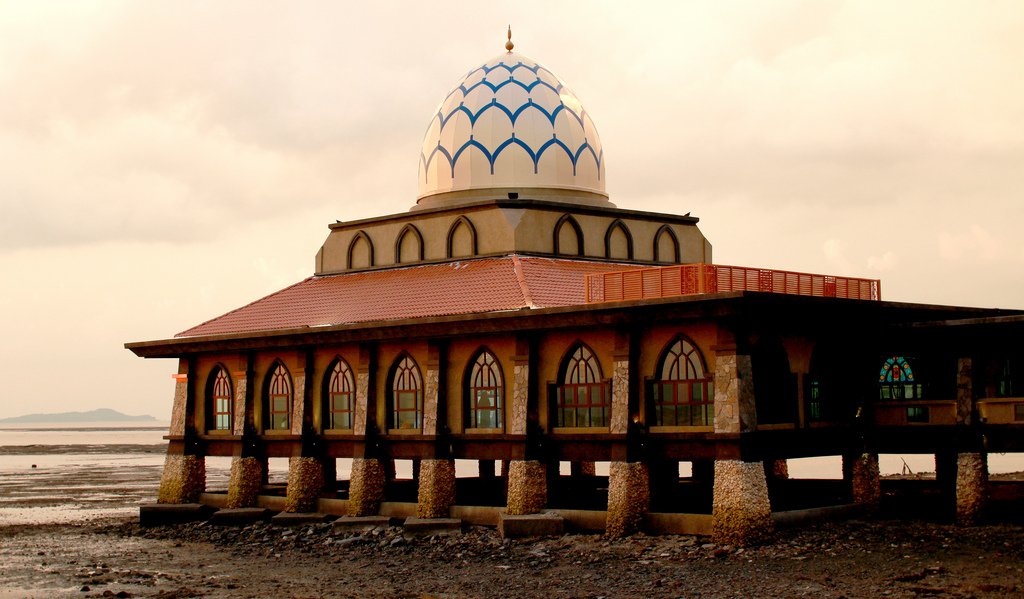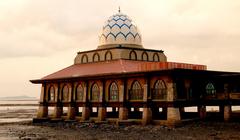
Visiting Masjid Al Hussain in Kangar, Malaysia: A Complete Guide
Date: 18/07/2024
Introduction
Welcome to the comprehensive guide to visiting Masjid Al Hussain in Kangar, Malaysia. This guide aims to provide you with all the essential information you need to make your visit a memorable and respectful experience. Masjid Al Hussain is more than just a mosque; it is a significant historical and cultural landmark that embodies the rich Islamic heritage of Perlis. Commissioned by the late Raja of Perlis, Tuanku Syed Putra Jamalullail, and completed in 1980, the mosque stands as a testament to royal patronage and Islamic identity in the region. Its architectural grandeur, blending Ottoman and traditional Malay styles, adds to its cultural and historical significance. Whether you are interested in the mosque’s history, architectural marvels, or community activities, this guide will provide you with practical information, including visiting hours, ticket prices, travel tips, and nearby attractions. For further insights into the rich history and architectural details, guided tours are available, making your visit to Masjid Al Hussain both enlightening and enjoyable.
Table of Contents
- Introduction
- Historical and Religious Significance
- Visitor Information
- Architectural Features
- Local Etiquette
- FAQ
- Conclusion
Historical and Religious Significance
A Symbol of Royal Patronage and Islamic Identity
Masjid Al Hussain stands as a testament to the deep-rooted Islamic faith in Perlis, Malaysia. Its construction was commissioned by the late Raja of Perlis, Tuanku Syed Putra Jamalullail, a ruler renowned for his piety and dedication to Islam. Completed in 1980, the mosque’s establishment reflects the historical significance of royal patronage in nurturing religious institutions within Malay society.
Architectural Grandeur Inspired by Ottoman and Malay Styles
The mosque’s design is a captivating blend of Ottoman and traditional Malay architectural elements. The majestic dome, a prominent feature in Ottoman architecture, dominates the skyline, symbolizing the celestial vault and the grandeur of Islamic art. This dome is complemented by four towering minarets, echoing the call to prayer and representing the mosque’s role as a spiritual beacon for the community.
The incorporation of local Malay architectural styles is evident in the mosque’s intricate wooden carvings and decorative motifs. These elements, often seen in traditional Malay palaces and mosques, add a touch of local heritage and craftsmanship to the overall design.
A Hub for Religious Observances and Community Gatherings
Since its inception, Masjid Al Hussain has served as the principal mosque of Perlis, holding immense religious significance for the local Muslim community. It is a focal point for daily prayers, Friday sermons, and significant Islamic events such as Ramadan and Eid celebrations.
Beyond its religious function, the mosque plays a vital role as a community center. It hosts religious classes, lectures, and workshops, fostering Islamic knowledge and understanding among people of all ages. This aspect underscores the mosque’s role as not just a place of worship but also a center for learning and social interaction within the community.
Visitor Information
Visiting Hours and Tickets
Masjid Al Hussain is open to visitors daily, with specific hours set aside for non-Muslim tourists to ensure the sanctity of prayer times. Visitors are encouraged to check the mosque’s official website for the latest visiting hours and any potential changes. There is no entrance fee, but donations are welcome to support the mosque’s upkeep.
Travel Tips and Nearby Attractions
Perlis is a small state, making travel to Masjid Al Hussain convenient. The mosque is easily accessible by car or public transport. Nearby attractions include the Perlis State Park, the Royal Palace of Arau, and the bustling Kayang Square. These sites offer a glimpse into the rich cultural and natural heritage of the region.
Special Events and Photography
Masjid Al Hussain hosts several special events throughout the year, including religious festivals and community gatherings. Visitors might also enjoy guided tours that provide deeper insights into the mosque’s history and architecture. The mosque and its surroundings offer numerous photographic opportunities, especially during sunset when the dome and minarets are beautifully illuminated.
Architectural Features
Overall Design and Structure
The mosque boasts a spacious prayer hall that can accommodate a large number of worshippers. Its most striking feature is the large, triple-tiered roof, a common element in traditional Malay architecture. This cascading roofline not only adds visual interest but also serves a practical purpose, providing natural ventilation and shade from the tropical sun.
Minarets and Domes
While the mosque incorporates traditional elements, it diverges from the conventional design with its minarets. Instead of the typical towering structures, Masjid Al Hussain features four shorter, decorative minarets that flank the main prayer hall. These minarets, adorned with intricate Islamic calligraphy, add a touch of elegance and grandeur to the mosque’s facade.
The mosque’s central dome, a prominent feature in Islamic architecture, is strategically placed above the main prayer hall. Its size and central location symbolize the mosque’s importance as a place of worship and community gathering.
Interior Design and Decoration
The interior of Masjid Al Hussain is equally impressive, featuring intricate details and a serene ambiance conducive to prayer and reflection.
- Mihrab: The mihrab, a niche in the wall indicating the direction of Mecca, is ornately decorated with geometric patterns and calligraphy, serving as a focal point within the prayer hall.
- Minbar: The minbar, a pulpit used for sermons, is crafted from fine wood and features intricate carvings, reflecting the mosque’s attention to detail.
- Calligraphy: Islamic calligraphy, an integral part of Islamic art, adorns the mosque’s interior walls. Verses from the Quran, rendered in elegant Arabic script, enhance the spiritual atmosphere and serve as reminders of Islamic teachings.
- Geometric Patterns: Geometric patterns, another hallmark of Islamic art, are incorporated throughout the mosque’s design. These intricate patterns, often found in tiles and screens, add visual complexity and symbolize the infinite nature of Allah.
Materials and Color Palette
The mosque’s construction utilizes a combination of modern and traditional materials. Reinforced concrete provides the structural framework, while marble, granite, and timber add a touch of elegance and warmth.
The mosque’s color palette is equally harmonious. The predominant use of white, both inside and out, creates a sense of purity and tranquility. This neutral backdrop is accented by subtle hues of gold, green, and blue, often found in the calligraphy, geometric patterns, and stained glass windows, adding visual interest and symbolic meaning.
Landscaping and Surroundings
The mosque’s serene atmosphere extends beyond its walls. Lush landscaping surrounds the building, creating a tranquil oasis within the bustling city. Palm trees, flowering shrubs, and manicured lawns provide shade and enhance the mosque’s aesthetic appeal.
Water features, often incorporated into Islamic architecture to symbolize purity and life, are also present. Fountains and reflecting pools not only enhance the visual appeal but also create a soothing ambiance, inviting contemplation and reflection.
Local Etiquette
General Etiquette
- Greetings: A polite greeting in Malay, such as “Assalamualaikum” (peace be upon you), is always appreciated.
- Photography: While photography is generally permitted within the mosque compound, it is important to be mindful and respectful. Avoid taking photos of people praying or during sermons. It is always best to ask for permission before taking photos, especially inside the prayer hall.
- Noise Level: Maintain a quiet and respectful demeanor within the mosque. Avoid loud talking, laughter, or any behavior that may disturb others.
- Physical Contact: Public displays of affection are considered inappropriate.
- Eating and Drinking: Eating, drinking, and smoking are strictly prohibited within the mosque compound.
During Prayer Times
- Non-Muslim Visitors: Non-Muslim visitors are welcome to observe prayers from a respectful distance but are not permitted to enter the prayer hall during prayer times.
- Silence: Observe complete silence during prayer times, even if you are not participating.
- Walking in Front of Worshippers: Avoid walking in front of people who are praying.
Interactions
- Respect for Elders: Show respect to elders by greeting them first and using polite language.
- Dress Code: Be mindful of your attire and ensure it adheres to the mosque’s dress code.
- Sensitivity: Remember that you are visiting a place of worship. Be sensitive to the religious practices and beliefs of others.
FAQ
Q: What are the visiting hours for Masjid Al Hussain? A: The mosque is open daily, but specific hours for non-Muslim tourists may vary. Check the official website for updated visiting hours.
Q: Is there an entrance fee to visit Masjid Al Hussain? A: There is no entrance fee, but donations are appreciated.
Q: Are there guided tours available? A: Yes, guided tours are available and provide valuable insights into the mosque’s history and architecture.
Q: What are some nearby attractions to Masjid Al Hussain? A: Nearby attractions include the Perlis State Park, the Royal Palace of Arau, and Kayang Square.
Q: Can I take photographs inside the mosque? A: Photography is allowed, especially in the outer areas. However, it is recommended to be respectful and avoid disrupting worshippers.
Conclusion
Masjid Al Hussain in Kangar, Malaysia, is a cornerstone of Islamic faith and cultural heritage in Perlis. Its historical significance, architectural splendor, and role as a community center make it a must-visit destination. The mosque not only serves as a place of worship but also as a hub for learning and social interaction, fostering a sense of community among locals and visitors alike. With its blend of Ottoman and traditional Malay architectural styles, the mosque offers a visually stunning and spiritually enriching experience. Whether you are visiting for its religious significance, architectural beauty, or cultural activities, Masjid Al Hussain provides a profound and memorable experience. We encourage you to plan your visit, explore the nearby attractions, and immerse yourself in the rich cultural tapestry of Perlis. For more information and updates, download our mobile app Audiala and follow us on social media.
